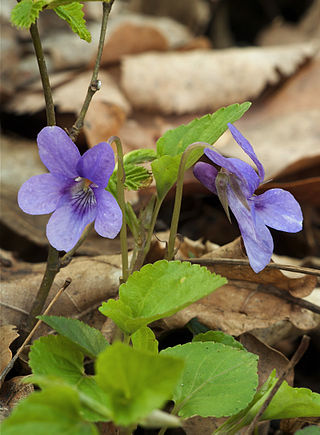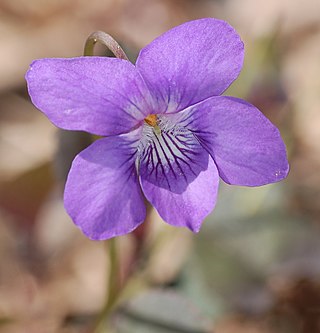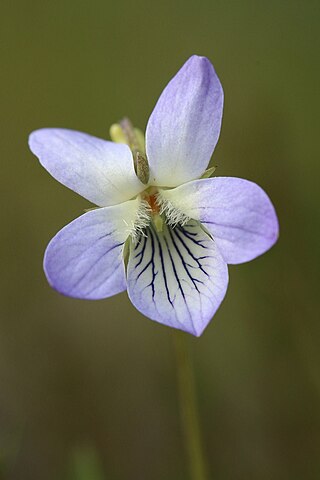
Viola is a genus of flowering plants in the violet family Violaceae. It is the largest genus in the family, containing between 525 and 600 species. Most species are found in the temperate Northern Hemisphere; however, some are also found in widely divergent areas such as Hawaii, Australasia, and the Andes.

Viola canina is a species of the genus Viola, native to Europe, where it is found in heaths, fens, and moist woodlands, especially on acidic soils.

Viola riviniana, the common dog-violet, is a species of flowering plant in the family Violaceae, native to Eurasia and Africa. It is also called wood violet and dog violet. It inhabits woodland edges, grassland and shady hedge banks. It is found in all soils except those which are acid or very wet.

Viola odorata is a species of flowering plant in the genus Viola, native to Europe and Asia. This small hardy herbaceous perennial is commonly known as wood violet, sweet violet, English violet, common violet, florist's violet, or garden violet. It has been introduced into North America and Australia.

The pearl-bordered fritillary is a butterfly of the family Nymphalidae found in Europe and through Russia across the Palearctic to the north of Kazakhstan.
Adder's tongue is a common name for several plants and may refer to:

Erythronium dens-canis, the dog's-tooth-violet or dogtooth violet, is a bulbous herbaceous perennial flowering plant in the family Liliaceae, growing to 25 cm (10 in). It is native to central and southern Europe from Portugal to Ukraine. It is the only naturally occurring species of Erythronium in Europe. Despite its common name, it is not closely related to the true violets of genus Viola.

Viola sororia, known commonly as the common blue violet, is a short-stemmed herbaceous perennial plant that is native to eastern North America. It is known by a number of common names, including common meadow violet, purple violet, woolly blue violet, hooded violet, and wood violet. Its cultivar 'Albiflora' has gained the Royal Horticultural Society's Award of Garden Merit. This perennial plant species is distributed in the eastern half of the United States, Canada and a part of Eastern Mexico. Their native habitats are rich, moist woods, and swamps located in the eastern half of the United States and Canada.

Bush violet or bush-violet is a common name for several plants and may refer to:

Viola labradorica, commonly known as alpine violet, American dog violet, dog violet or Labrador violet, is a perennial herbaceous flowering plant. It is native to Greenland, eastern Canada, and the eastern United States. The plant sold as Viola labradorica by nurseries is Viola riviniana.

The term bane, in botany, is an archaic element in the common names of plants known to be toxic or poisonous.

Viola reichenbachiana, also known as the early dog-violet, pale wood violet, slender wood violet, hedge violet, or wood dog violet, is a species of flowering plant in the Viola genus. This species hybridises with Viola riviniana, the common dog-violet, to produce Viola × bavarica.. The plant is named after the 19th century botanist Ludwig Reichenbach. It is a rhizomatous herbaceous perennial that is widely known for its purple petals, and it typically resides along road banks or among other rich vegetation, as other wild pansies do. The name dog violet refers to its lack of scent, making it supposedly only fit for dogs.
Wood violet is a common name for several plants and may refer to:
Golden violet is a common name for several violets with yellow flowers and may refer to:
Goosefoot or goose foot may refer to:

Viola lactea, also known by its common name pale dog violet, is a species of flowering planet of the family Violaceae.
This page is based on this
Wikipedia article Text is available under the
CC BY-SA 4.0 license; additional terms may apply.
Images, videos and audio are available under their respective licenses.











